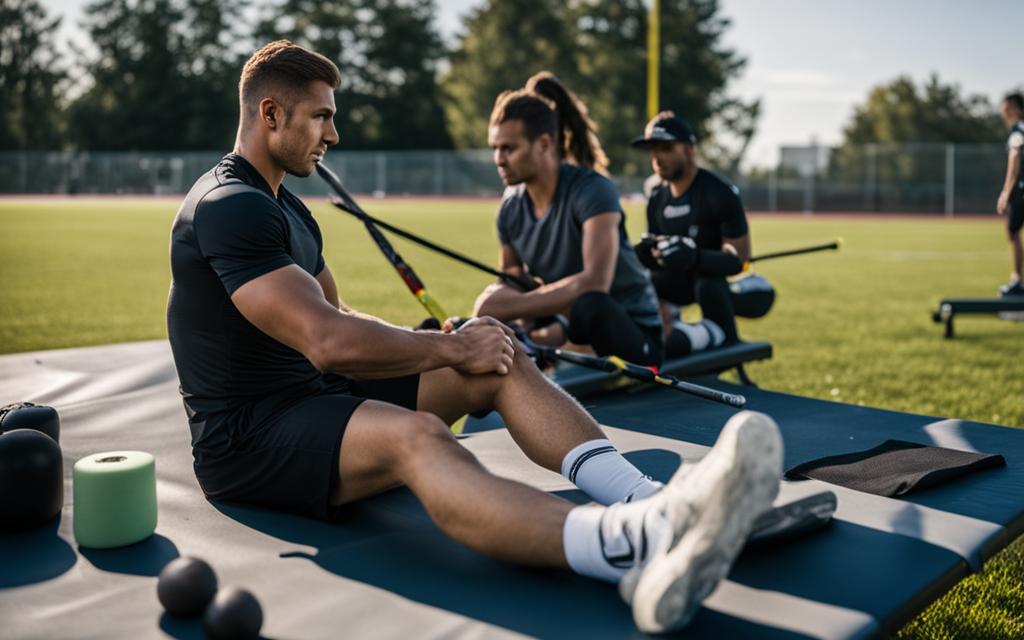Greetings, readers! Today, I want to talk about the importance of building resilience in the world of sports and how sports medicine approaches can help prevent injuries. As an athlete, I understand the physical and mental demands that come with participating in sports, and I believe that resilience is a key factor in ensuring long-term success and well-being.
Sports medicine plays a crucial role in helping athletes stay healthy, recover from injuries, and optimize their performance. By incorporating proactive strategies, athletes can minimize the risk of injuries and enhance their overall athletic abilities.
In this article, we will explore various sports medicine techniques and practices that can aid in injury prevention. We will delve into the world of sports injury treatment, prevention exercises, rehabilitation, and the specialized care provided by sports medicine specialists. Additionally, we will discuss practical tips for athletes to minimize the chances of injuries, manage athletes’ injury, and create comprehensive sports injury prevention programs.
Through a comprehensive approach that combines physical and psychological resilience, mindfulness techniques, coping mechanisms, and the importance of a balanced lifestyle, athletes can build the resilience needed to overcome challenges, prevent injuries, and achieve their performance goals.
Join me on this journey as we uncover the secrets of building resilience in sports and learn how we can leverage sports medicine to optimize our well-being and reach new heights in our athletic endeavors.
Key Takeaways:
- Sports medicine plays a vital role in preventing injuries and optimizing performance.
- Proactive strategies such as sports injury prevention exercises and specialized care can minimize the risk of injuries.
- Incorporating mindfulness techniques and coping mechanisms can enhance athletes’ resilience and well-being.
- A growth mindset and strong support systems are essential for athletes to thrive.
- A balanced lifestyle, including rest and recreational activities, is crucial for injury prevention.
The Role of Resilience in Athletes’ Well-being and Performance
Resilience plays a crucial role in the well-being and performance of athletes. It refers to an athlete’s ability to maintain psychological and physical well-being in the face of adversity.
Psychological resilience in sports enables athletes to face challenges, setbacks, and stressors with strength and determination, while physical resilience in sports allows athletes to recover from physical strain and injuries.
Resilience is vital for athlete well-being as it helps them navigate the ups and downs of their sporting journey and maintain a healthy mindset. By developing resilience, athletes can improve their overall well-being and enhance their performance on the field.
Psychological resilience in sports has a significant impact on athletes’ mental health. When athletes cultivate resilience, they develop coping strategies to manage stress, maintain focus, and stay motivated. This enables them to perform at their best and reduces the risk of burnout.
Furthermore, resilience is closely linked to athlete performance. Athletes with higher levels of resilience are better equipped to handle pressure, setbacks, and challenges that occur during training and competition. They can bounce back from failures, learn from their experiences, and strive for continuous improvement.
Setting realistic goals and focusing on the positives are essential aspects of resilience in athletes. Setting achievable goals helps athletes stay motivated and maintain a sense of progress, while emphasizing the positives promotes a positive mindset, self-belief, and confidence.
Seeking support when needed is another crucial element of resilience in athletes. Athletes should feel comfortable reaching out to coaches, sports medicine specialists, teammates, or mental health professionals for guidance and assistance. Support systems play a vital role in helping athletes navigate difficulties and maintain overall well-being.
In conclusion, resilience is a fundamental component of athlete well-being and performance. By developing psychological and physical resilience, athletes can successfully overcome challenges, manage stress, set realistic goals, focus on the positives, and seek support when needed. Building resilience enables athletes to enhance their well-being and optimize their performance in sports.
Understanding the Impact of Stress on Sports Injury Risk
Stress is a significant factor in the risk of sports injuries. Whether the stress is negative or positive, it can have detrimental effects on an athlete’s well-being and increase the likelihood of injury. The correlation between stress and sports injuries is well-documented. Both the physiological and psychological effects of stress can compromise an athlete’s physical condition and impair their ability to perform at their best.
Physiologically, stress activates the body’s stress response, triggering the release of hormones such as cortisol and adrenaline. These hormones can lead to increased muscle tension, reduced flexibility, impaired coordination, and decreased immune function. These physical changes increase the susceptibility to injuries in athletes.
Psychologically, stress can impact an athlete’s focus, concentration, decision-making, and reaction time. When under stress, athletes may become more susceptible to distractions and errors, increasing their likelihood of accidents and injuries during sports activities.

Managing stress is crucial in mitigating the risk of sports injuries. Effective stress management techniques can help athletes maintain optimal physical and psychological well-being. By incorporating stress management strategies into their training and daily routines, athletes can reduce stress levels, improve their resilience, and decrease their vulnerability to injuries.
Some recommended stress management techniques in sports include:
- Practicing mindfulness and meditation to promote relaxation and focus
- Engaging in regular physical exercise to release tension and promote overall well-being
- Developing effective time management skills to reduce stress related to competing demands
- Implementing stress-reducing activities such as hobbies, socializing, and pursuing interests outside of sports
- Seeking support from sports medicine specialists and mental health professionals to learn coping strategies and develop resilience
By understanding the impact of stress on sports injury risk and actively managing stress, athletes can optimize their performance, reduce the likelihood of injuries, and maintain long-term physical and psychological well-being.
Sports Medicine and Injury Prevention: A Proactive Strategy
Comprehensive Care in Sports Medicine
Sports medicine plays a critical role in injury prevention through a holistic and proactive approach. Athletes can benefit from comprehensive care that encompasses regular check-ups, injury risk assessments, and personalized treatment plans. By undergoing regular check-ups, athletes can address any underlying medical conditions or potential risk factors that may predispose them to injuries. The injury risk assessments conducted by sports medicine specialists help identify specific areas of vulnerability, allowing for targeted preventive interventions.
Personalized treatment plans are essential in sports medicine for addressing individual athletes’ unique needs and goals. By understanding athletes’ biomechanics, training regimens, and injury history, sports medicine specialists can tailor preventive strategies to minimize the risk of injuries. This comprehensive care in sports medicine ensures that athletes receive the necessary support, guidance, and interventions to optimize their overall health, well-being, and performance.
Preventive Techniques and Exercises
Preventive techniques and exercises play a vital role in minimizing the risk of sports injuries. Athletes can incorporate specific exercises into their training routines to enhance strength, flexibility, and balance, which are essential for injury prevention. These exercises focus on targeted muscle groups, joint stability, and proprioception, enabling athletes to maintain proper form and alignment during sports activities.
Additionally, sports medicine specialists may design sports injury prevention programs that include injury-specific exercises and training protocols. These programs aim to strengthen the muscles and joints commonly affected by sports injuries, reducing the risk of strains, sprains, and overuse injuries. Through regular practice of these exercises and adherence to the preventive programs, athletes can improve their biomechanics, physical performance, and overall resilience to sports-related injuries.
| Preventive Techniques | Benefits |
|---|---|
| Strength training | Enhances muscle strength and joint stability |
| Flexibility exercises | Improves range of motion and prevents muscle imbalances |
| Balance training | Enhances proprioception and reduces the risk of falls |
| Proper technique training | Promotes correct form and posture during sports activities |
By incorporating preventive techniques and exercises in their training routines, athletes can optimize their performance, reduce the likelihood of injuries, and prolong their athletic careers.
Incorporating Mindfulness and Psychological Resilience Techniques
Mindfulness and psychological resilience techniques are essential in the field of sports to prevent injuries and enhance overall well-being. By incorporating these practices, athletes can effectively manage their emotions, reduce stress levels, and develop a strong foundation of resilience. This section explores two key techniques that athletes can use to cultivate mindfulness and psychological resilience: the R.A.I.N technique and mindful breathing and relaxation exercises.
R.A.I.N. Technique to Manage Emotions
The R.A.I.N. technique is a mindfulness practice that involves recognizing, accepting, investigating, and nurturing our emotions. By adopting this technique, athletes can develop emotional intelligence and gain better control over their reactions, consciously redirecting their responses to challenging situations.
The R.A.I.N. technique can be particularly helpful in sports settings where intense emotions can arise during training or competitions. By acknowledging and accepting emotions without judgment, athletes create space for self-reflection and the opportunity to choose responses that align with their goals and values.
Using the R.A.I.N. technique, athletes can:
- Recognize and label their emotions, bringing awareness to their internal experiences.
- Accept and allow these emotions to be present, without trying to suppress or ignore them.
- Investigate the underlying causes and triggers of their emotions, seeking to understand their origins.
- Nurture and respond to their emotions with kindness and self-compassion, fostering a supportive inner dialogue.
By practicing the R.A.I.N. technique regularly, athletes can develop emotional resilience and effectively manage their emotions, reducing the risk of stress-related injuries.
Mindful Breathing and Relaxation Exercises
Mindful breathing and relaxation exercises are powerful tools to promote mental clarity, reduce stress, and enhance overall well-being. These practices help athletes cultivate a calm and focused state of mind, enabling them to perform at their best and prevent injuries.
Practicing mindful breathing involves paying attention to the breath and observing its natural rhythm. This technique helps athletes release tension, improve concentration, and maintain a calm and centered mindset during training and competitions.
Relaxation exercises, on the other hand, help athletes effectively manage stress and recover from intense physical demands. Techniques such as progressive muscle relaxation, guided imagery, and meditation can aid in reducing muscle tension, promoting restful sleep, and facilitating the body’s natural healing processes.
By incorporating mindful breathing and relaxation exercises into their regular routines, athletes can cultivate a strong sense of mental and physical resilience, ultimately reducing the risk of injuries and optimizing their performance.

Add tables, if needed.
Coping Mechanisms for Athletes Facing Injuries
Coping with injuries is a challenging experience for athletes. When faced with injuries, it is essential for athletes to employ effective coping mechanisms that can help them navigate the recovery process and return to their sport safely. This section explores two key coping mechanisms: staying connected with the team and sport, and seeking support from sports medicine specialists.
Staying Connected with the Team and Sport
One of the most crucial coping mechanisms for athletes facing injuries is staying connected with their team and sport. Despite being physically unable to participate, maintaining emotional and psychological connections can provide a sense of belonging and support during the recovery period. Athletes can:
- Attend team practices and games, even if they are unable to participate.
- Engage in team activities and events to stay connected with teammates.
- Stay updated on team news and developments.
By staying connected with the team and sport, athletes can maintain their motivation and sense of identity, which can contribute to a faster and smoother recovery process.
Seeking Support from Sports Medicine Specialists
Another vital coping mechanism for athletes facing injuries is seeking support from sports medicine specialists. Sports medicine specialists have the expertise and knowledge to guide athletes through their recovery journey and provide essential care and treatment. Athletes can:
- Consult with sports medicine specialists to develop a personalized rehabilitation plan.
- Follow the recommended treatment protocols and attend regular appointments.
- Seek guidance and assistance in managing pain and discomfort.
By seeking support from sports medicine specialists, athletes can ensure they receive the professional care they need and minimize the risk of further complications or setbacks.
Overall, coping with injuries requires a combination of emotional, psychological, and medical support. By staying connected with the team and sport while seeking guidance from sports medicine specialists, athletes can effectively manage their injuries and make a successful comeback.

Fostering a Growth Mindset Within Athletes
Fostering a growth mindset is essential for athletes to enhance their performance and prevent injuries. A growth mindset is the belief that abilities and skills can be developed through dedication and hard work. Athletes with a growth mindset are more likely to embrace challenges, persist in the face of setbacks, and continuously seek improvement.
A growth mindset has a profound impact on athletes’ motivation, determination, and resilience. By believing in their ability to grow and improve, athletes are more likely to set ambitious yet realistic goals, push themselves outside their comfort zones, and embrace the learning process as an integral part of their journey. This mindset creates a positive cycle of self-improvement, helping athletes strive for excellence while overcoming obstacles.
To develop a growth mindset, athletes can implement various strategies:
- Setting realistic goals: Athletes should set specific, measurable, attainable, relevant, and time-bound (SMART) goals that challenge them to stretch their abilities without becoming overwhelming. These goals provide a sense of direction and motivation for growth.
- Embracing challenges: Athletes should view challenges as opportunities for growth and self-improvement. By stepping outside their comfort zones and tackling new and difficult tasks, athletes can develop new skills, build resilience, and expand their potential.
- Learning from setbacks: Athletes should see setbacks as learning experiences rather than failures. By analyzing their mistakes, seeking feedback, and identifying areas for improvement, athletes can bounce back stronger and more prepared to overcome future challenges.
By fostering a growth mindset, athletes can unlock their full potential, improve their overall performance, and reduce the risk of injuries. It is essential for coaches, sports medicine specialists, and support systems to foster and reinforce a growth mindset within athletes to empower them on their athletic journey.
Building Strong Support Systems Through Sports Medicine Care
Building strong support systems is crucial for athletes to thrive in their sports journey and prevent injuries. Effective communication, collaboration, and coordination among sports medicine specialists, coaches, and other members of the support team play a vital role in providing comprehensive care for athletes.
Sports medicine support systems ensure that athletes receive the necessary guidance, resources, and care to prevent injuries and optimize their performance. By working together, sports medicine specialists and coaches can combine their expertise to create personalized training and rehabilitation programs tailored to the specific needs of each athlete.
Proactive sports medicine care for athletes involves regular check-ups, injury risk assessments, and ongoing monitoring of progress. With the support of sports medicine specialists, athletes can take proactive measures to prevent injuries, such as implementing injury prevention techniques, participating in proper warm-up and cool-down routines, and maintaining optimal physical condition.
Additionally, sports medicine support systems provide athletes with access to a network of healthcare professionals, including physiotherapists, nutritionists, and psychologists, who contribute to their overall well-being and injury prevention. These multidisciplinary teams work collaboratively to address any physical, mental, or emotional challenges athletes may face.
Through comprehensive care and ongoing support, sports medicine specialists help athletes build resilience and minimize the risk of injuries. By nurturing a strong support system, athletes can confidently pursue their sports goals, knowing they have a team dedicated to their well-being and success.
“A strong support system is essential for athletes. By combining the expertise of sports medicine specialists, coaches, and other professionals, athletes can receive comprehensive care that maximizes their performance potential and minimizes the risk of injuries.”
| Benefits of Building Strong Support Systems in Sports Medicine |
|---|
| Enhanced injury prevention and risk reduction |
| Improved performance optimization |
| Access to a network of healthcare professionals |
| Customized training and rehabilitation programs |
| Ongoing monitoring and progress evaluation |
Evaluating and Learning from Setbacks in Sports
Setbacks are inevitable in sports, and how athletes respond to these setbacks can impact their resilience and injury prevention. It is essential for athletes to evaluate and learn from these setbacks to enhance their overall performance. By embracing setbacks as valuable learning opportunities, athletes can develop resilience and minimize the risk of injuries.
One effective strategy for resilience-building is self-reflection. Athletes can take the time to analyze the setback, identify areas for improvement, and set new goals to overcome challenges. Self-reflection allows athletes to gain valuable insights into their performance, mindset, and training strategies.
Another strategy is goal setting. By setting specific, measurable, achievable, relevant, and time-bound (SMART) goals, athletes can regain their focus and motivation after a setback. Goals provide athletes with a sense of direction and purpose, helping them navigate through adversity and stay on track.
Seeking feedback is also crucial in the evaluation process. Athletes can consult with coaches, teammates, and sports medicine specialists to gain different perspectives and insights. Feedback helps athletes gain a better understanding of their strengths and weaknesses, enabling them to make necessary adjustments for future success.
The ability to learn from setbacks and adapt accordingly is a valuable skill for athletes in injury prevention. By evaluating setbacks, implementing effective strategies, and maintaining a resilient mindset, athletes can continue to improve their performance while minimizing the risk of injuries.
The Importance of a Balanced Lifestyle for Injury Prevention
A balanced lifestyle is crucial for athlete well-being and injury prevention. By creating a balance between training, rest, and recreational activities, athletes can optimize their performance and reduce the risk of injuries. Prioritizing a balanced lifestyle allows athletes to maintain their physical and mental health, supporting their long-term success in sports.
Creating a Balance: Training, Rest, and Recreational Activities
One essential aspect of a balanced lifestyle for athletes is finding the right equilibrium between training, rest, and recreational activities. While rigorous training is crucial for improving skills and physical capabilities, overtraining without adequate rest can lead to fatigue, burnout, and an increased risk of injuries.
A well-designed training program should include scheduled rest days to allow the body to recover and repair. Rest days provide an opportunity for muscle growth, reducing the likelihood of muscle imbalances and overuse injuries. Additionally, integrating recreational activities into an athlete’s routine can provide mental refreshment and prevent monotony, improving motivation and overall well-being.
It is important for athletes to listen to their bodies and adjust their training and rest accordingly. Paying attention to signs of fatigue, such as decreased performance, persistent muscle soreness, or disrupted sleep patterns, can help athletes prevent injuries by allowing for adequate recovery.
“A balanced lifestyle is like a puzzle. Each piece, whether it’s training, rest, or recreational activities, needs to fit together to create a harmonious and resilient athlete.”
– Anonymous
Coaches’ Role in Encouraging Athletes’ Life Balance
Coaches play a vital role in encouraging and supporting athletes in achieving a balanced lifestyle. They have the responsibility to educate athletes about the importance of rest and recovery, emphasizing the role it plays in injury prevention and long-term performance.
Coaches can incorporate various strategies to promote a balanced lifestyle, such as implementing structured training plans that include rest days or offering guidance on recreational activities that complement an athlete’s training goals. Additionally, coaches should foster open communication with athletes, creating a supportive environment where athletes can express their concerns about training load, stress levels, and overall well-being.
By collaborating with sports medicine specialists, coaches can further enhance their understanding of the training-rest balance and ensure the athletes under their guidance are receiving comprehensive care. This collaborative effort reinforces the significance of a balanced lifestyle and injury prevention as a collective responsibility within the sports community.
| Benefits of a Balanced Lifestyle | Training | Rest | Recreational Activities |
|---|---|---|---|
| Prevents overuse injuries | Enhances performance | Promotes recovery | Reduces stress |
| Improves mental well-being | Builds strength and endurance | Prevents burnout | Enhances motivation |
| Supports overall health | Enhances skills and technique | Reduces fatigue | Provides mental refreshment |
Training Smarter with the ‘Training-Injury Prevention Paradox’
The training-injury prevention paradox is a concept that highlights how higher training loads in sports can both increase and decrease the risk of injuries. To prevent injuries while optimizing performance, athletes must adopt smarter training strategies. This section will discuss key strategies for training smarter and reducing injury risk through training.
One important aspect of training smarter is the appropriate grading of training loads. Athletes should gradually increase their training intensity and volume to allow their bodies to adapt and minimize the risk of injury. Monitoring training load is also essential, as it helps athletes and coaches identify potential warning signs of overtraining or excessive stress on the body.
Another factor to consider in training program design is the inclusion of injury prevention exercises and techniques. This may involve incorporating specific strength and conditioning exercises that target the muscles and movements most prone to injury in a particular sport. Additionally, athletes should engage in dynamic warm-up routines and flexibility exercises to improve joint mobility and reduce the risk of strains or sprains.
Understanding the training-injury prevention paradox requires athletes to strike a balance between pushing their training limits and allowing sufficient recovery time. Rest and recovery are crucial components of smart training, as they give the body time to repair and adapt to the stress of training. Adequate sleep, nutrition, and hydration also play significant roles in optimizing recovery and reducing injury risk.
To reinforce the importance of training smarter, let’s examine the following table that highlights the key principles and strategies for injury prevention through training.
| Training Smarter Principles | Strategies |
|---|---|
| Appropriate Training Load | Gradually increase training intensity and volume |
| Monitoring Training Load | Use wearable technology or training logs to track training intensity and duration |
| Injury Prevention Exercises | Incorporate sport-specific strength and conditioning exercises, dynamic warm-ups, and flexibility routines |
| Rest and Recovery | Ensure sufficient rest and recovery time, prioritize sleep, nutrition, and hydration |
The table and the image above provide a comprehensive overview of the strategies and principles of training smarter to prevent injuries. By implementing these strategies, athletes can reduce their risk of injuries while maximizing their performance potential.
Conclusion
In conclusion, the key to preventing injuries in sports lies in building resilience. By implementing effective sports medicine approaches, incorporating mindfulness and psychological resilience techniques, fostering a growth mindset, and creating strong support systems, athletes can enhance their well-being, reduce their risk of injuries, and optimize their performance.
It is crucial for athletes, coaches, and sports medicine specialists to prioritize resilience-building strategies. By recognizing the importance of mental and physical well-being, athletes can take proactive steps to prevent injuries and promote long-term success in their sports endeavors.
Remember, resilience is not only about bouncing back from setbacks but also about proactively preparing the mind and body for the challenges ahead. Through comprehensive sports medicine care, athletes can receive the necessary support, guidance, and resources to thrive in their athletic careers and enjoy injury-free participation in their chosen sports.
By prioritizing resilience and injury prevention, athletes can optimize their performance, ensure longevity in their sports careers, and achieve their goals with confidence and determination.
FAQ
Why is building resilience important in sports?
How does stress impact the risk of sports injuries?
How can sports medicine help in injury prevention?
Are there specific techniques to enhance psychological resilience in sports?
How can athletes cope with injuries?
What is a growth mindset, and why is it important in sports?
How does sports medicine contribute to building strong support systems?
How can athletes learn from setbacks in sports?
Why is a balanced lifestyle important for injury prevention?
How can athletes train smarter to prevent injuries?
Source Links
- https://www.childrenshospital.org/sites/default/files/2022-03/building-a-resilient-athlete.pdf
- https://broadviewpsychology.com/2020/04/21/resilience-the-ways-to-enhance-this-critical-skill-in-sports/
- https://bjsm.bmj.com/content/50/5/273



